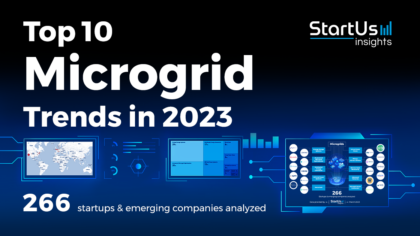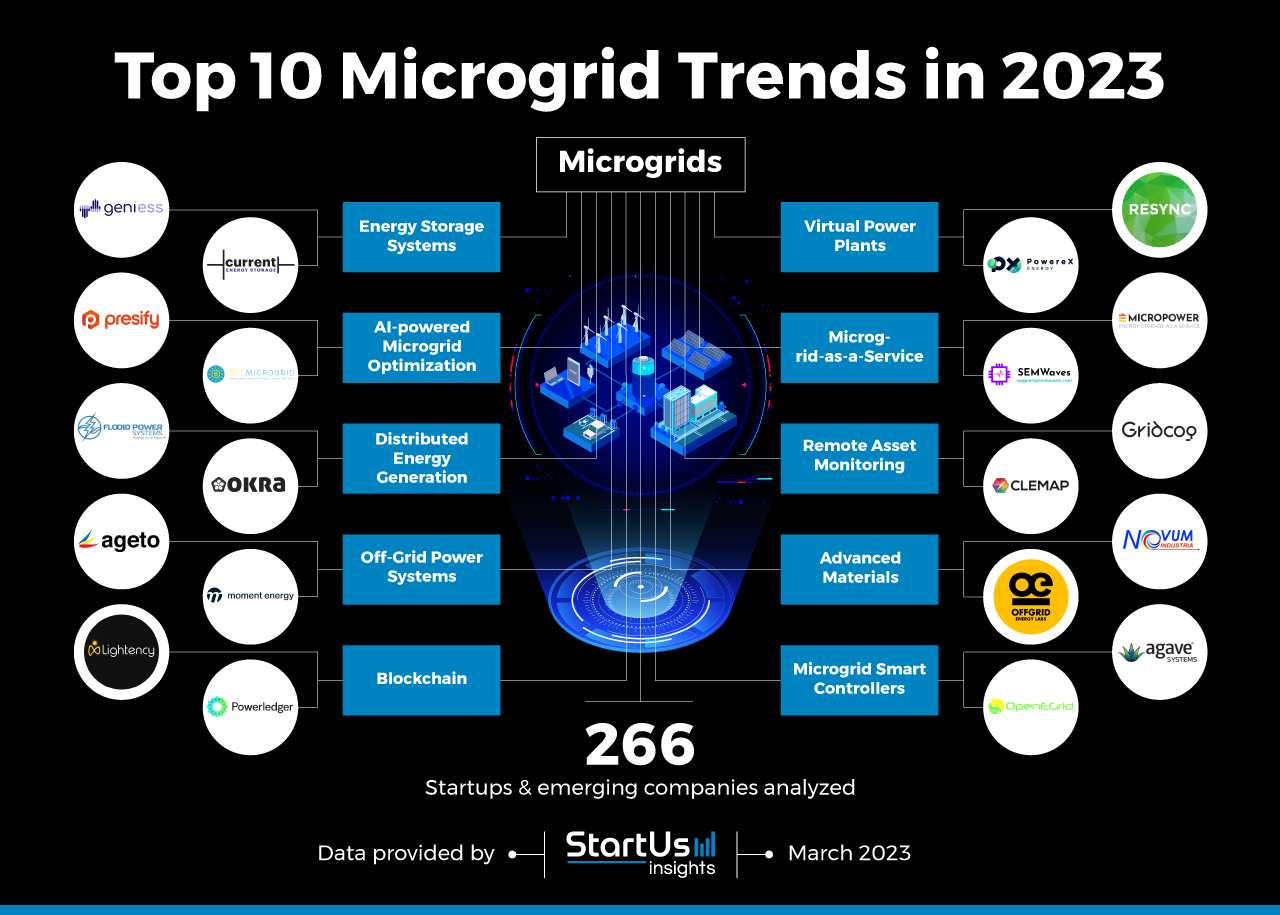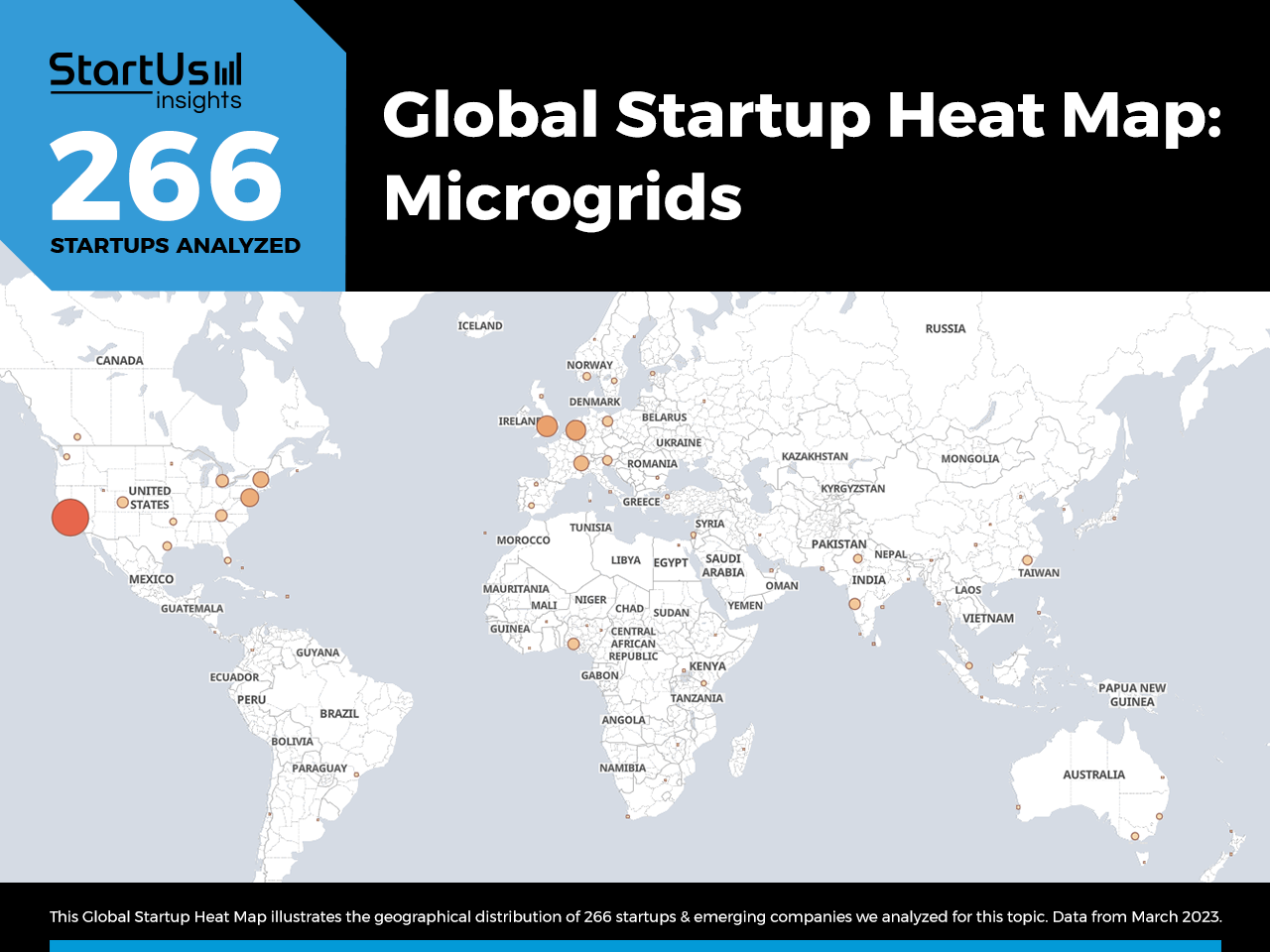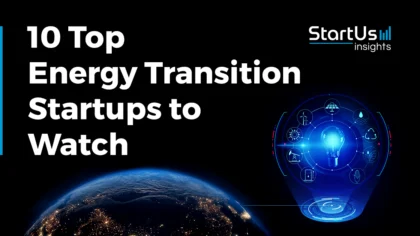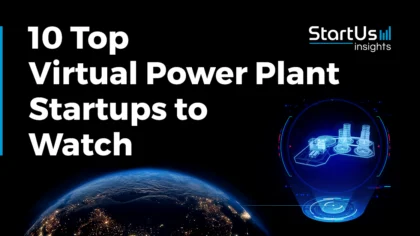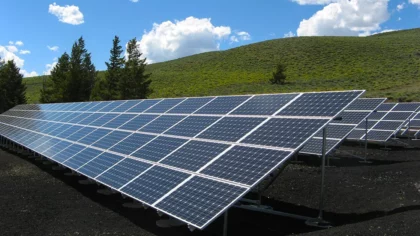Accelerate Productivity in 2025
Reignite Growth Despite the Global Slowdown
Today, power grids face significant challenges from aging infrastructure to cyber-attacks and natural disasters, which result in widespread outages, economic losses, and even loss of life. To tackle these issues, startups are leveraging renewable energy sources like solar and wind energy. Such systems also integrate advanced energy storage, like flow and kinetic batteries, to create resilient and distributed energy systems. Additionally, microgrid startups develop novel control systems to predict energy demand and optimize energy sources in real-time. They improve energy security and reduce carbon emissions to enhance the resilience of critical infrastructure in the face of unexpected disruptions. In this report, you get to explore the top 10 microgrid trends and innovative startups advancing the energy industry.
Innovation Map outlines the Top 10 Microgrid Trends & 20 Promising Startups
For this in-depth research on the Top Microgrid Trends & Startups, we analyzed a sample of 266 global startups & scaleups. This data-driven research provides innovation intelligence that helps you improve strategic decision-making by giving you an overview of emerging technologies in the energy industry. In the Microgrid Innovation Map below, you get a comprehensive overview of the innovation trends & startups that impact your company.
These insights are derived by working with our Big Data & Artificial Intelligence-powered StartUs Insights Discovery Platform, covering 3 790 000+ startups & scaleups globally. As the world’s largest resource for data on emerging companies, the SaaS platform enables you to identify relevant technologies and industry trends quickly & exhaustively.
Tree Map reveals the Impact of the Top 10 Microgrid Trends
Based on the Microgrid Innovation Map, the Tree Map below illustrates the impact of the Top 10 Microgrid Trends in 2023. Startups working on innovative energy storage systems (ESS) and advanced materials create grids with higher resilience while lowering the cost of high-capacity storage. Distributed energy generation further enhances grid functionality by integrating multiple sources of energy harvesting and smart power distribution systems. Off-grid power systems and microgrid-as-a-service also enable grid installations in remote areas with no access to any power or grid infrastructure. Further, remote asset monitoring assists in the maintenance of microgrid infrastructure and significantly reduces the time spent on manual inspection. Besides these, AI-powered microgrid optimizations and virtual power plants (VPPs) intelligently balance power generation with demand using energy demand forecasts. Lastly, blockchain ensures the transparency and security required for energy transitions in microgrids while smart controllers enable energy companies to operate their microgrid infrastructure efficiently.
Top 10 Microgrid Trends in 2023
- Energy Storage Systems
- AI-powered Microgrid Optimization
- Distributed Energy Generation
- Off-Grid Power System
- Blockchain
- Virtual Power Plants
- Microgrid-as-a-Service
- Remote Asset Monitoring
- Advanced Materials
- Smart Controllers for Microgrids
Global Startup Heat Map covers 266 Microgrid Startups & Scaleups
The Global Startup Heat Map below highlights the global distribution of the 266 exemplary startups & scaleups that we analyzed for this research. Created through the StartUs Insights Discovery Platform, the Heat Map reveals high startup activity in USA and Europe, followed by the Asia-Pacific region. Below, you get to meet 20 out of these 266 promising startups & scaleups as well as the solutions they develop. These microgrid startups are hand-picked based on criteria such as founding year, location, funding raised, & more. Depending on your specific needs, your top picks might look entirely different.
Top 10 Microgrid Trends in 2023
1. Energy Storage Systems
Renewable energy sources, like solar and wind, are inherently intermittent and cause disruptions in power supply and demand, destabilizing microgrids. To address this challenge, startups are developing advanced energy storage technologies like flywheel and flow batteries that provide backup power during periods of high demand. Additionally, startups offer innovative microgrid management platforms that leverage algorithms and simulations to determine the right energy storage for future microgrids. These energy storage solutions improve the reliability and efficiency of microgrids. This makes them more resilient to disruptions and equips energy producers to meet the energy needs of communities.
Geniess offers Energy Storage Asset Performance Simulations
Norwegian startup Geniess develops a platform to determine the performance of energy storage assets earlier in the decision-making process. The platform features cloud-based simulation tools to accurately understand each potential energy storage use case and avoid additional retrofitting or system over-sizing. It also visualizes the potential revenue generation of energy storage systems including peak-shaving, arbitrage, and local backup. Moreover, Geniess’s platform enables energy companies and grid installers to understand the potential value and risk in ESS installations.
Current Energy Storage creates Microgrid Backup Systems
Current Energy Storage is a US-based startup that develops battery energy storage systems for microgrids. The startup’s range of energy storage products integrate and communicate with assets such as on-site photovoltaic (PV) inverters, diesel, propane, and natural gas generators, as well as grid power systems. Current Energy Storage’s ELM FieldSight Microgrid Controller features sophisticated control and communication interfaces with autonomous optimization of balance between solar and gas generators. The startup also develops low-voltage and communication drawings for each site including site-specific line drawings.
2. AI-powered Microgrid Optimization
The distributed nature of energy generation in microgrids poses challenges in balancing energy demand and supply, which leads to inefficiencies, grid overloading, and power outages. To solve these challenges, startups provide AI-powered microgrid optimization solutions that utilize advanced algorithms and machine learning. They make real-time adjustments to energy distribution and storage. By optimizing energy use and balancing demand, such solutions improve the efficiency and reliability of the microgrid. This ensures stable power delivery to consumers even during times of high demand or unexpected energy supply fluctuations. These advances also enable microgrids to integrate more renewable energy sources and reduce carbon emissions.
Presify develops an Energy Management System
Turkish startup Presify makes an energy management system for microgrids to meet energy demand while considering resource constraints. It features models for energy production from renewable and non-renewable sources, energy demand, battery storage systems as well as the cost of infrastructure and maintenance. Presify systems also enable rural and off-grid energy system operators to plan battery charge and discharge as well as divert surplus energy from solar production to the grid or battery.
SolMicroGrid provides Client-controlled AI Systems
SolMicroGrid is a US-based startup that develops a client-controlled AI system to increase energy efficiency practices. The startup’s GridManager solution is a cloud-based energy dashboard that controls the quality of the peak load demand. The consumption-based software also tracks electricity, water use, garbage, and more with real-time statistics and reporting. Moreover, unlike conventional microgrids that only work with large buildings, SolMicrogrid’s solution works in microgrids that serve smaller buildings like retail outlets.
3. Distributed Energy Generation
Microgrids are small-scale power grids that operate independently from the main power grid and serve specific geographic areas and communities. Therefore, it is not viable to install long-distance transmission and distribution infrastructure, which are expensive, inefficient, and vulnerable to disruptions. This is why startups are making solutions to generate energy close to the consumers’ locations. Localized energy generation reduces energy losses and accelerates the integration of distributed energy resources (DERs). Moreover, this makes renewable energy more reliable in microgrids, which leads to more sustainable and environmentally friendly energy systems.
Flooid Power uses Solar Heat & Displacement
US-based startup Flooid Power advances distributed generation systems through solar energy generation and storage in microgrids. The startup’s Flooid Tower solution uses solar heat and displacement to continuously generate power within a self-contained and non-polluting unit. It features a gravitational conduit filled with Flooid that functions with a high-efficiency gas injection system and a modified hydroelectric turbine. Flooid Power’s solution finds applications in microgrids and distributed power applications to generate power close to the end user. This improves demand response and minimizes line loss.
Okra Solar promotes Solar Energy Redistribution
Okra Solar is an Australian startup that makes interconnected solar home systems to redistribute solar energy. The startup’s Okra Pod provides each household with up to 1,2 kilowatt (kW) of productive power and enables homes to interconnect and share excess power. Its smart system also provides alerts, payments, and firmware updates remotely via cellular networks. Okra Solar’s solution connects all components together in a mesh grid and ensures optimal energy redistribution between neighboring households.
4. Off-Grid Power Systems
Off-grid power systems are entirely reliant on renewable energy sources such as solar, wind, and hydropower to generate electricity. However, these sources depend on weather conditions, which leads to an unreliable power supply. Innovative off-grid power systems address this through more efficient and cost-effective renewable energy techniques, such as improved solar panels and battery storage systems. Additionally, advances in microgrid control systems and smart grid technologies make it easier to integrate off-grid power systems into microgrids. This makes microgrids more reliable and sustainable for energy generation in remote and off-grid areas.
Ageto Energy aids Off-grid Microgrid Management
US-based startup Ageto Energy provides microgrid controllers that integrate, optimize, and manage diverse energy resources. Its ARC microgrid controller and software feature real-time feedback on microgrid performance, load balancing with power flow controls and data analysis, and electrical demand trends. Ageto Energy also offers off-grid microgrids with primary user interfaces, real-time controls, and system monitoring, maximizing renewable energy usage.
Moment Energy manufactures Off-grid Energy Storage Systems
Moment Energy is a Canadian startup that repurposes retired electric vehicle (EV) batteries to create energy storage systems for off-grid systems. Its ESS uses scalable 48 kWh lithium-ion blocks that run multiple long-duration cycles per day. The ESS also features remote monitoring through wifi to monitor battery operation and send performance alerts in case of fault detection. Moreover, Moment Energy’s second life-based ESS reduces the cost of implementing microgrids in remote locations that have no alternative access to other electrical infrastructure.
5. Blockchain
One of the main problems with microgrids is the lack of a secure and efficient system to manage energy transactions among multiple entities. Blockchain provides a decentralized and transparent way of managing transactions. It allows microgrid operators to efficiently manage energy distribution and payments between multiple parties. With blockchain, microgrid startups create smart contracts that automatically execute transactions based on predefined conditions, such as the availability of energy, pricing, and demand. Blockchain also provides a high level of security and immutability, which prevents unauthorized access to microgrid data and ensures transaction integrity.
Lightency builds a Web3 Energy Marketplace
French startup Lightency creates a web3 energy marketplace to help users participate in globalizing renewable energy adoption while earning a passive income. The startup’s peer-to-peer (P2P) platform utilizes light tokens in Lightency’s decentralized autonomous organization (DAO). It allows token holders to participate in governance and decision-making by choosing energy projects that interest them. The startup’s energy platform also gathers all energy stakeholders in a single platform to lower the cost of electricity while creating new revenue streams for prosumers and grid operators.
Powerledger ensures Transparent Energy Trading
Powerledger is an Australian startup that develops software for the tracking, tracing, and trading of renewable energy. The startup’s uGrid solution is a blockchain-based platform that provides detailed usage data and consumption tracking to identify energy use. Moreover, it facilitates the creation of local energy marketplaces with trading rules that are based on inputs from energy operators. uGrid enables energy tracking and trading within embedded networks and microgrids. It finds applications in shopping centers, apartment complexes, and office buildings with individual or co-owned energy assets.

6. Virtual Power Plants
Microgrids are difficult to manage since they aggregate and distribute energy from DERs such as solar panels, wind turbines, storage systems, and more. Startups are reducing the complexity of such aggregations through the use of virtual power plants, which are networks of DERs that are centrally controlled and managed. Moreover, VPPs optimize energy usage and predict energy demand accurately by utilizing technologies like cloud computing and machine learning, making microgrids more efficient. VPP startups also provide additional revenue streams for DER owners by enabling participation in energy markets and demand response programs.
Resync offers Microgrid Asset Analytics
Singaporean startup Resync provides intelligent virtual power plants to generate actionable insights to support data-driven decisions. The startup’s platform monitors the total yield of energy generation in real time through connected assets with AI-based analytics on occupancy and indoor air quality sensors. Besides, it features energy forecasting and asset optimization with heatmap analysis to enable predictive maintenance. Resync’s solution allows microgrid operators to reduce energy wastage while simultaneously controlling carbon emissions.
Powerex develops AI-driven Virtual Power Plants
Powerex is a Slovakian startup that offers a VPP platform that enables real-time access to the energy markets for all connected energy assets. Its solution, PX Grid, offers comprehensive modeling of power grids and microgrids that also monitors and controls energy assets and real-time system optimization. Powerex’s platform features grid resilience and AI-driven continuous forecasting. Moreover, the startup’s VPPs enable microgrids to connect with and monitor online assets such as batteries, biogas units, small hydro plants, EV chargers, etc.
7. Microgrid-as-a-Service
The adoption of microgrids currently involves high initial costs of installation and maintenance, making them unaffordable for many communities and organizations. Microgrid-as-a-Service removes the need for investing in costly infrastructure since users pay only for the energy they use. This approach enables greater access to microgrids, particularly in underserved areas, and provides a steady revenue stream for microgrid providers. Additionally, microgrids use internet of things (IoT) sensors and real-time analytics to achieve highly optimized energy networks. Microgrid startups enable the monitoring and analysis of energy usage patterns, which streamlines management and also reduces energy waste.
Micropower Energy advances Solar Capture & Storage
Brazilian startup Micropower Energy provides hybrid microgrid solutions with solar integration and storage to provide reliable energy in remote areas. Its microgrids feature tariff optimization by reducing consumption through the discharge of stored energy when it is most expensive and then recharging when energy is cheaper. The startup’s battery energy storage system (BESS) supplies dependable backup energy during outages at response times superior to diesel generators. This helps operators reduce facility downtime while improving power quality. Micropower Energy’s solution addresses the challenge of installing multi-component microgrids in remote regions by providing a complete solar energy generation and storage solution.
SEMWaves drives Rural Electrification
SEMWaves is a UK-based startup that builds a patented all-weather hybrid microgrid to deliver cost-effective renewable energy. The startup provides rural villages with microgrids and maintenance services via a lease-to-own (LTO) or energy-as-a-service (EaaS) contract. SEMWaves’ microgrids are market-ready and kW-scale solutions that provide stable energy service year-round that are also unaffected by adverse weather conditions. This enables the sustainable long-term electrification of remote communities through minimal capital and operating expenditure.
8. Remote Asset Monitoring
Deploying microgrids in remote areas makes traditional methods of manual inspection, monitoring, and maintenance costly and time-consuming. To address these issues, startups are developing remote asset monitoring solutions that provide real-time data and analytics to detect potential issues and optimize performance. The use of IoT sensors and ML algorithms enables preventative maintenance and fault detection, reducing the risk of system downtime and improving overall reliability. With the ability to remotely monitor microgrid assets, operators make informed decisions regarding maintenance and repair to increase grid uptime. Additionally, operators enable quick and efficient monitoring or maintenance of remote microgrid assets by using drones in inspections and maintenance.
Gridcog develops Energy Simulation & Tracking Solutions
Australian startup Gridcog develops software to plan, track, and optimize microgrids. The startup provides a wide range of technologies for power grids including PV systems, wind turbines, BESS, generators, and more. Further, Gridcog integrates data from site meters, asset telemetry, irradiance, wind, and more to track and report on the actual and modeled performance of microgrids. Gridcog’s simulation and tracking of microgrid data enable grid operators to identify performance issues in existing installations and simulation models of future installations.
CLEMAP manufactures Energy Measuring Devices
Clemap is a Swiss startup that develops intelligent energy monitoring to remotely manage microgrid infrastructure. The startup’s energy-measuring device collects high-resolution data at a high sampling rate which enables the detection of anomalies, failures, and hotspots. Additionally, the sensors are customizable as they support remote updates to introduce new functions and analytics modules. In this way, the remote grid data serve as a basis for optimization and also provides transparency in grid usage.
9. Advanced Materials
The main limiting factors for microgrids are energy generation and storage capacities that affect the delivery of consistent and uninterrupted power to users. Therefore, startups make advanced materials to improve the efficiency and durability of energy storage systems. For instance, some startups develop new battery technologies, such as solid-state batteries that offer higher energy densities and longer lifetimes compared to Li-ion batteries. Such new materials also create more efficient and durable solar panels and wind turbines, which increase the overall power capacity of microgrids.
Novum Industria manufactures Superconductors
US-based startup Novum Industria specializes in large-scale low and high-temperature superconducting magnet design and development. The startup creates low-temperature superconductors (LTS) and high-temperature superconductors (HTS) through a process of advanced engineering methods and tools. They comprise simulations and analyses, including coupled ‘multi-physics’ analyses, critical testing, and evaluation. Novum Industria’s superconductors find applications in fusion and other advanced power systems, superconducting cable-in-conduit conductor analysis, and increasing power grid efficiency.
Offgrid Energy Labs creates Conductive Electrolytes
Off Grid Energy Labs is an Indian startup that makes efficient, safe, and sustainable battery chemicals. Its ZincGel battery uses a high conductive electrolyte and a carbon-based cathode for high-speed charge and discharge with no risk of side reactions and no gas evolution. Besides, ZincGel is self-healing, temperature-stable, and built with recyclable materials. The startup’s solution promotes the installation of microgrids by reducing the lifecycle cost of batteries used in microgrid systems.
10. Microgrid Smart Controllers
Managing complex and dynamic interactions between different energy sources and loads causes instability and inefficiencies in microgrids. Smart controllers leverage ML algorithms and AI to optimize microgrid operations in real-time and balance energy supply to ensure reliable and efficient electricity. These smart controllers also integrate with other technologies, such as ESS and renewable energy sources, to further enhance microgrid performance and resiliency. As a result, microgrid operators reduce their operating costs, improve energy reliability and security, and support the transition to more sustainable energy.
Agave Systems provides Automated Energy Controllers
US-based startup Agave Systems develops intelligent industrial control tools for managing multiple energy sources and prioritizing loads. Its Evolution microgrid controller automates the function of distributed generation assets. The controller handles the management of resource loads for stand-by scenarios, reporting of exporting capacity, and more. Additionally, the Agave supply module optimizes operations through data analytics and also reduces operational costs. In this way, the controller provides grid resilience and enables stakeholders to understand their data and reduce costs.
OpenEGrid creates an On-Site Management System
OpenEGrid is a UK-based startup that offers a hardware platform to manage microgrids. Its on-site management system, Apollo, features a front-end computer system with an embedded operating system that communicates with its cloud platform to monitor and control microgrids. The hardware platform also facilitates the implementation of policies such as California rule 21, DER aggregation, the creation of VPPs, and demand response. Together with OpenEgrid’s massively scalable cloud platform, Apollo helps microgrid operators coordinate, control, and optimize their electrical infrastructure.
Discover all Microgrid Trends, Technologies & Startups
AI-based grid optimization and virtual power plants are gaining importance due to their ability to actively balance power generation and distribution. Additionally, the increasing adoption of electric vehicles (EVs) and their supporting infrastructure promotes the adoption of microgrid-as-service. The microgrid trends & startups outlined in this report only scratch the surface of trends we identified during our data-driven innovation & startup scouting process. Identifying new opportunities & emerging technologies to implement into your business goes a long way in gaining a competitive advantage.
